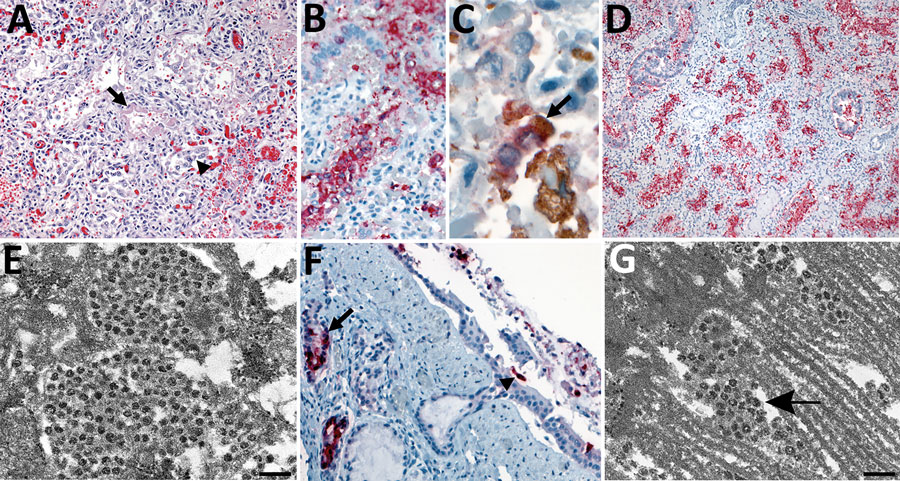Volume 28, Number 3—March 2022
Synopsis
Detection of SARS-CoV-2 in Neonatal Autopsy Tissues and Placenta
Figure 1

Figure 1. Pulmonary histopathologic, immunohistochemical (IHC), in situ hybridization, and ultrastructural findings in tissues from a neonate in the United States with severe acute respiratory syndrome coronavirus 2 (SARS-CoV-2). A) Lower magnification of the lung showing diffuse alveolar damage, characterized by type II pneumocyte hyperplasia (arrowhead), hyaline membrane (arrow), and interstitial mononuclear infiltrate. Original magnification ×20. B) Extensive intra-alveolar immunostaining by spike protein SARS-CoV-2 IHC assay. Original magnification ×40. C) Double-stain IHC assay showing rare macrophages with SARS-CoV-2/CD-163–positive immunostaining. Red, SARS-CoV-2; brown, CD-163 antibody (arrow). Original magnification ×63. D) Extensive staining of SARS-CoV-2 genomic RNA in pneumocytes by nucleocapsid gene in situ hybridization assay. Original magnification ×10. E) Electron microscopy (EM) image of a pneumocyte containing accumulations of intracellular viral particles. Scale bar indicates 200 nm; viral particles were on average 65 nm in diameter, smaller than commonly observed because of shrinkage during processing. F) Immunostaining of tracheal epithelial cells (arrowhead) and submucosal glands (arrow) by SARS-CoV-2 nucleocapsid IHC assay. Original magnification ×20. G) EM image of a ciliated epithelial cell with extracellular viral particles (arrow) associated with the cilia. Scale bar indicates 200 nm. EM images were collected from 4-μm sections of formalin-fixed, paraffin-embedded tissues affixed to glass slides that were embedded for EM.
1These authors contributed equally to this article.